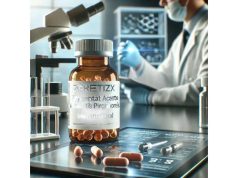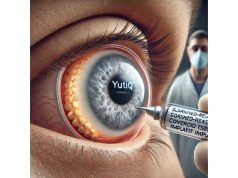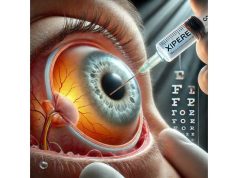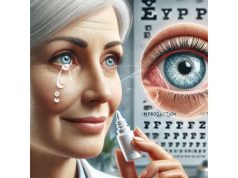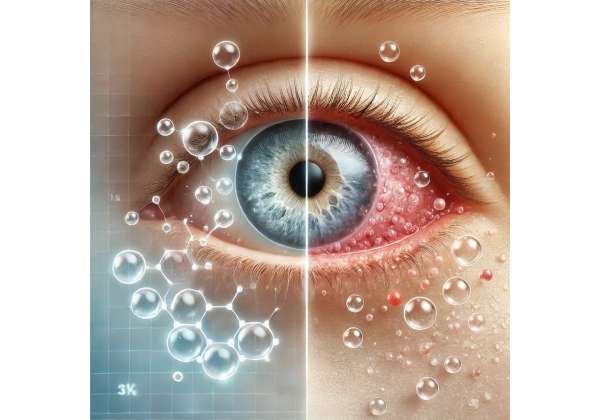
Dry eye syndrome affects millions of people worldwide, leading to symptoms such as irritation, grittiness, excessive tearing, and blurred vision. While over-the-counter lubricating drops or medicated ointments can offer temporary relief, many sufferers seek alternative therapies that address the root causes—often involving inflammation and oxidative stress. In recent years, molecular hydrogen (H₂) has entered the spotlight as a potential natural remedy to help mitigate these underlying factors. By acting as a selective antioxidant, hydrogen therapy could hold promise for those looking to maintain or restore a comfortable ocular surface.
Unlike conventional treatments that mainly address superficial symptoms, hydrogen therapy aims to neutralize damaging free radicals in a targeted way. This, in turn, may support tear film stability and overall eye health, especially in individuals with persistent dryness. Although research is ongoing, hydrogen therapy’s gentle, non-invasive nature has piqued the curiosity of healthcare practitioners and patients alike. For anyone who has struggled with chronic dryness, inflammation, or discomfort in the eyes, molecular hydrogen may provide a valuable adjunct—potentially paving a path toward long-lasting relief.
Understanding Molecular Hydrogen’s Role in Dry Eye Relief
Molecular hydrogen (chemical formula H₂) is a colorless, odorless gas found in trace amounts within Earth’s atmosphere. Over the past decade, medical researchers have explored hydrogen’s ability to act as a selective antioxidant, neutralizing particularly harmful species of reactive oxygen. When we speak of oxidative stress in the context of dry eye, we refer to the damaging imbalance that occurs when free radicals outpace the body’s natural antioxidant defenses. In the eyes, this can lead to inflammation, cellular disruption in the tear glands, and compromised tear film.
Why Oxidative Stress Matters in Dry Eye
Dry eye syndrome frequently arises from inadequate tear production, excessive tear evaporation, or an imbalance in the tears’ chemical makeup. However, at a microscopic level, one of the main culprits behind the deterioration of tear film integrity can be oxidative stress. Environmental factors like pollution, cigarette smoke, or constant exposure to digital screens can contribute to the formation of reactive oxygen species (ROS). When these ROS accumulate on the eye’s surface or within the lacrimal glands, they degrade proteins and lipids essential to tear stability. The result is a cycle of irritation, redness, and inflammation—fueling the very dryness that makes daily life uncomfortable.
Molecular hydrogen enters this equation by selectively scavenging ROS that are particularly damaging. Whereas some antioxidants might indiscriminately target all free radicals—even those the body might use as part of its normal immune responses—hydrogen appears more focused on species such as the hydroxyl radical (·OH). By mitigating oxidative damage in tissues that contribute to tear production and ocular surface health, H₂ may help maintain or restore the tear film’s protective layers.
Potential Anti-Inflammatory Effects
A hallmark of many chronic eye conditions, especially dry eye, is inflammation. Pro-inflammatory cytokines and mediators can heighten discomfort, perpetuate dryness, and degrade ocular surface tissues. Studies examining hydrogen therapy in other inflammatory conditions have noted reductions in markers like tumor necrosis factor-alpha (TNF-α) and interleukins (IL-1, IL-6). Although clinical data specific to dry eye remain limited, these anti-inflammatory properties raise the possibility that hydrogen therapy might soothe irritated eyes by dialing down the inflammatory process at a cellular level.
Some ophthalmologists and integrative medicine practitioners hypothesize that H₂ might also protect corneal epithelial cells, which form the outermost layer of the cornea. If these cells remain healthier and less inflamed, the overall tear film quality and visual clarity often improve. While more robust research is needed, anecdotal reports and early-stage studies suggest that daily or regular exposure to hydrogen-infused solutions could benefit individuals struggling with persistent dryness.
Delivery Methods and Practicality
Hydrogen therapy’s versatility is partly what makes it appealing. Individuals can harness molecular hydrogen in various ways—through inhalation devices, hydrogen-rich water, or topical applications like eye drops designed to release H₂ directly onto the ocular surface. Each method aims to saturate local tissues with an optimal concentration of hydrogen without introducing potentially harsh chemicals. For those worried about side effects, hydrogen’s well-documented safety profile is reassuring. In fact, hydrogen gas has been used in deep-sea diving mixtures for decades without significant adverse effects when properly administered.
Still, not all hydrogen products on the market are created equal. Quality control, concentration levels, and delivery mechanisms can vary. For instance, some commercially available “hydrogen water” may contain negligible amounts of H₂, offering little therapeutic impact. As more companies rush to produce hydrogen-based eye drops and topical solutions, healthcare providers emphasize the importance of choosing reputable brands and verifying that product claims align with actual hydrogen content.
Complementing Traditional Dry Eye Therapies
Because dry eye syndrome can have multiple triggers, from meibomian gland dysfunction to hormonal imbalances and environmental irritants, a well-rounded treatment plan might incorporate standard approaches—such as artificial tears, punctal plugs, or nutritional supplements—alongside emerging therapies like molecular hydrogen. Integrative specialists view hydrogen therapy not as an outright replacement for proven treatments, but rather as an additional strategy to tackle the oxidative and inflammatory components of the condition. Patients who respond favorably may find that they rely less on lubricating drops or experience fewer flare-ups of redness and irritation.
It is worth noting, though, that while molecular hydrogen is widely considered safe, individuals with severe or advanced dry eye should continue to seek medical advice. In certain cases, prescription medications or more invasive interventions (like lipid-based tear formulations or therapeutic contact lenses) may be necessary. Nonetheless, for mild to moderate forms of dryness or as a preventative measure, hydrogen therapy stands out as a gentle, potentially powerful tool to foster ocular comfort and resilience.
Practical Steps: How to Apply Hydrogen Therapy for Ocular Health
The idea of using molecular hydrogen to support eye health might sound complicated, but in practice, therapies can be surprisingly straightforward. Whether administered at home or in a clinical setting, the key is to ensure consistent, adequately dosed exposure. Below are common methods by which individuals incorporate hydrogen into their routine, along with important considerations for safety and effectiveness.
Hydrogen-Rich Eye Drops
Eye drops formulated to deliver hydrogen directly to the ocular surface are perhaps the most intuitive option for those with dry eye. Typically, these drops contain water that has been infused with molecular hydrogen under specific conditions. Since hydrogen is highly volatile and can escape from a solution over time, manufacturers often use specialized packaging or add stabilizing agents to slow this process.
- Usage Guidelines: Most hydrogen-based eye drops recommend several daily applications, similar to artificial tears. Unlike many medicated drops, there is usually no wait time between doses, and they can be used alongside other therapies.
- Storage and Handling: To retain efficacy, these drops should be stored in a cool environment, away from direct sunlight. Some products even come in single-use vials to ensure maximum freshness and hydrogen content.
- Potential Interactions: While hydrogen is considered safe, patients using other prescription drops—like cyclosporine or steroid drops—should consult an eye care professional to stagger application times and prevent dilution of critical medications.
Hydrogen Inhalation and Systemic Effects
Hydrogen inhalation devices have gained popularity for a range of health applications, from improving athletic recovery to reducing oxidative stress in chronic diseases. Although this method is less targeted to the eyes than topical drops, inhalation can saturate the bloodstream with hydrogen, potentially delivering indirect benefits to ocular tissues.
- Setup: Home-based inhalation units typically provide a nasal cannula through which the user inhales hydrogen-enriched air. The duration of a session can vary from 15 minutes to an hour, depending on the device.
- General Wellness: Beyond eye health, inhalation may support overall antioxidant capacity in the body, which could indirectly benefit conditions like dry eye that have systemic inflammatory or oxidative components.
- Clinical Monitoring: While widely regarded as low-risk, inhalation therapy should still be undertaken with some caution, especially for individuals with respiratory concerns. Monitoring by a healthcare provider is advisable for those with complex medical histories.
Hydrogen-Rich Water and Dietary Integration
Oral intake of hydrogen-rich water is another route that some advocates suggest. By drinking water infused with H₂, users aim to boost internal antioxidant defenses. Although this method is not specific to the eyes, improved systemic oxidative balance can positively influence ocular tissues.
- Absorption and Timing: Experts recommend consuming hydrogen water in smaller, more frequent doses throughout the day rather than large quantities in one go. This approach is believed to sustain more consistent levels of hydrogen in the bloodstream.
- Combined Approaches: Some individuals combine oral intake with topical application, hoping to achieve a two-pronged benefit that tackles dryness from within and at the ocular surface.
- Drawbacks: The level of hydrogen that remains dissolved in water depends on factors like temperature, packaging, and the time elapsed since production. Checking for reliable lab tests or using a recommended generator at home can help ensure meaningful hydrogen concentrations.
Integrating With Lifestyle and Supportive Measures
Whether administered through drops, inhalation, or drinking water, hydrogen therapy can be woven into a broader lifestyle strategy aimed at eye health. For instance, taking regular breaks from digital devices, wearing protective eyewear in windy or dry conditions, and maintaining adequate hydration can all complement the benefits of H₂. Additionally, certain nutritional supplements—like omega-3 fatty acids—may work synergistically with hydrogen by reducing inflammation and stabilizing tear film.
It’s also important for patients to engage in routine eye examinations. Periodic check-ups with an optometrist or ophthalmologist ensure that dryness symptoms are properly monitored and that any underlying conditions, such as blepharitis or meibomian gland dysfunction, are promptly addressed. Used consistently and in tandem with best-practice ocular hygiene, molecular hydrogen could form part of a well-rounded plan to ward off dryness and protect long-term visual comfort.
Scientific Data and Clinical Findings on Molecular Hydrogen
Although research on molecular hydrogen is still evolving in the field of ophthalmology, a growing number of studies highlight its antioxidant and anti-inflammatory benefits. Some of this research focuses specifically on conditions affecting the eye, while other findings come from broader investigations into how hydrogen influences cellular health and inflammation throughout the body. Below, we’ll explore notable studies, papers, and real-world insights that shed light on hydrogen’s potential role in easing dry eye symptoms.
Early Laboratory Investigations
In Acta Ophthalmologica (2016), a preliminary lab study explored hydrogen’s effects on cultured corneal epithelial cells exposed to oxidative stress. Researchers found that cells treated with hydrogen-infused media displayed fewer markers of oxidative damage compared to untreated counterparts. The authors posited that hydrogen’s selective scavenging of hydroxyl radicals might shield vital proteins from irreversible oxidation, suggesting a foundation for its protective capacity in dry eye.
Another in vitro experiment published in the International Journal of Ophthalmic Research (2017) investigated hydrogen’s interaction with inflammatory cytokines. The results showed that hydrogen administration attenuated IL-1β and TNF-α levels in ocular cell cultures subjected to inflammatory triggers. While laboratory data cannot directly translate to clinical outcomes, these findings laid the groundwork for exploring hydrogen in live animal models and human trials.
Animal Model Research
In a study highlighted by the Journal of Ocular Pharmacology and Therapeutics (2018), researchers induced dry eye symptoms in a rodent model and treated one group with hydrogen-rich saline eye drops. After several weeks, the treated group exhibited improved tear break-up times, reduced corneal staining, and lower inflammatory markers compared to controls. Notably, histological examination suggested that the hydrogen therapy helped preserve goblet cells—specialized cells in the conjunctiva that produce mucus to stabilize the tear film. While rodent models are not a perfect proxy for humans, these findings pointed toward a tangible, biological basis for hydrogen’s protective effects on the ocular surface.
Clinical Trials and Observational Studies
Human clinical trials examining hydrogen’s impact on dry eye are still relatively limited, but some early-stage investigations are promising. In a small-scale pilot trial published in the Asian Journal of Ophthalmology (2019), 20 patients with mild to moderate dry eye received topical hydrogen-infused eye drops three times daily for two months. By the end of the study, most participants reported improved comfort, lower ocular surface disease index (OSDI) scores, and better tear film stability. Tear osmolarity measurements—often elevated in dry eye—also decreased, suggesting a more balanced tear film.
Moreover, observational data presented at the 2021 American Academy of Ophthalmology conference showcased a case series in which hydrogen inhalation therapy was added to standard care for 15 individuals suffering from various ocular surface diseases, including severe dry eye. While not a controlled trial, the authors noted that patients receiving hydrogen inhalation reported faster relief from irritation and less dependency on lubricating drops compared to those following standard therapy alone. These findings warrant larger randomized trials, but they highlight a potential additive effect of hydrogen in supportive ocular care.
Potential Mechanisms of Action
Scholars and clinicians propose multiple overlapping mechanisms by which molecular hydrogen could alleviate dry eye:
- Selective Antioxidant Activity: By targeting the most toxic ROS, hydrogen prevents cell damage that could disrupt tear production and degrade corneal epithelium.
- Inflammation Modulation: Hydrogen seems to inhibit key inflammatory mediators, reducing swelling and irritation that contribute to dryness.
- Cellular Homeostasis: There is some indication that hydrogen fosters a healthier balance of enzymes and proteins within ocular tissues, potentially supporting tear film components like lipids, mucin, and aqueous fluid.
Although these hypotheses are increasingly backed by experimental data, researchers emphasize that hydrogen is not a cure-all. Its effectiveness may vary among individuals, and underlying anatomical issues, such as blocked meibomian glands or severe autoimmune disorders, may limit how much relief hydrogen alone can provide. Nevertheless, hydrogen’s largely favorable safety profile and apparent synergy with standard therapies continue to drive interest in this field.
Observational Insights and Real-World Feedback
Outside the confines of formal studies, many integrative medical clinics and ophthalmology practices have anecdotally observed benefits when patients incorporate hydrogen therapy into their daily routines. Practitioners sometimes document shorter durations of dryness flare-ups, improved tolerance to digital screens, and even a decrease in corneal surface staining. Patients who have tried numerous over-the-counter drops often describe a subtle yet steady improvement in eye comfort over a span of weeks.
Industry organizations that monitor alternative health trends note that while hydrogen-based products are proliferating—ranging from potable hydrogen water to portable inhalation devices—quality assurance remains inconsistent. This discrepancy might explain why some individuals rave about hydrogen’s beneficial effects while others notice little change. As a result, leading researchers continue to advocate for rigorous standardization of hydrogen products, complete with verifiable concentration measurements, to ensure reliable therapeutic outcomes.
Future Directions
With an increasing number of studies hinting at hydrogen’s potential, future research will likely pivot towards larger, placebo-controlled trials—particularly in humans with a formal diagnosis of dry eye disease. Protocols that investigate optimal dosing, frequency of application, and specific subtypes of dry eye (e.g., evaporative vs. aqueous-deficient) are in high demand. Combining hydrogen with advanced drug delivery systems might further enhance its longevity on the ocular surface, possibly translating to even better results.
Ultimately, the convergence of basic science, animal experiments, and early human data underscores the plausibility that molecular hydrogen can support eye health through multiple pathways. While some questions remain—such as the best method of administration and ideal treatment intervals—the evidence is mounting that hydrogen could be a valuable and natural adjunct in the management of dry eye syndrome.
Evaluating Safety and Potential Benefits for Dry Eye
When considering any new therapy for dry eye, safety and effectiveness go hand in hand. Molecular hydrogen’s long history of use in diving gas mixtures and medical research suggests a high degree of safety, especially at the low concentrations typically deployed for therapeutic applications. Most reported side effects are either nonexistent or extremely mild, such as transient stinging if the eye drops are improperly formulated.
In terms of potential benefits, hydrogen therapy may help reduce ocular surface inflammation and lessen oxidative stress. For some patients, this translates into fewer bouts of redness, improved tear film stability, and less reliance on lubricating drops. Although individual responses vary, the therapy’s multi-faceted mechanism of action—targeting both free radicals and inflammatory mediators—offers a promising avenue for those struggling with persistent dryness. Particularly in mild to moderate dry eye, hydrogen could serve as a gentle intervention that complements standard medical regimens or lifestyle adjustments.
As with any therapy, individuals should consult an eye care specialist if symptoms persist or worsen. While hydrogen appears safe for most, people with complex medical conditions or severe ocular diseases might need a more intensive treatment plan. Nonetheless, for many, the potential gains in comfort and ocular health are compelling enough to justify a trial of hydrogen-based interventions, especially when guided by a knowledgeable clinician.
Cost Considerations and Accessibility
The price of hydrogen therapy products varies widely, influenced by factors such as delivery method and brand reputation. Basic hydrogen-infused eye drops may cost anywhere from \$20 to \$50 for a one-month supply, while more sophisticated inhalation or water-generating devices can run into the hundreds—or even thousands—of dollars. Insurance coverage is generally limited, as hydrogen therapy is not yet considered a mainstream medical intervention for dry eye. However, some flexible spending accounts (FSAs) or health savings accounts (HSAs) may allow for partial reimbursement if prescribed by a licensed healthcare provider.
Medical Disclaimer:
This article is for informational purposes only and not a substitute for professional medical advice. Always consult a qualified healthcare professional for personalized recommendations concerning dry eye treatments and therapies.
If you found this article insightful, consider sharing it on Facebook or X (formerly Twitter) so others can explore the potential benefits of molecular hydrogen for dry eye syndrome.

